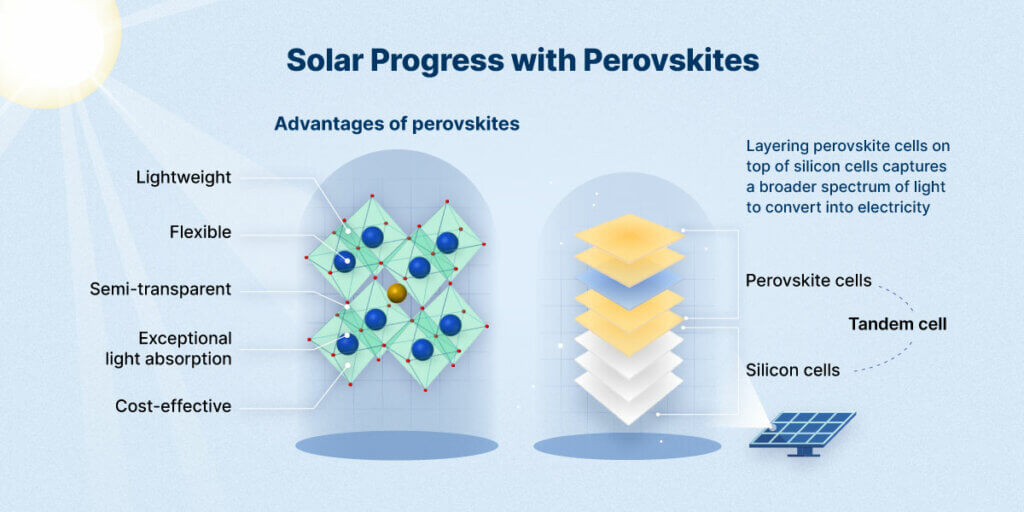What if we could build solar panels with higher energy efficiency, faster manufacturing, and even cheaper costs?
As the world increasingly turns to renewable energy sources, the solar cell industry stands at a pivotal crossroads. Investment in renewables is on the rise, and the cost of solar panels continues to fall. However, challenges remain in terms of capacity and scalability, making technological innovation more critical than ever.
As the world explores different ways to enhance solar panel technology, one key focus is improving the efficiency of solar cells. Perovskites, defined by their crystal structure ABX3, have emerged as a promising solution, sparking the interest of both scientists and enterprises. When layered on top of silicon to create what is known as tandem solar cells, perovskite can significantly increase the amount of sunlight that can be converted to electricity, meaning perovskite may have the potential to revolutionize traditional silicon solar cells.
In this article, we’ll dive into the world of perovskites and understand their pivotal role in improving solar cell efficiency via tandem cells. Read on to explore why this class of materials is now at the forefront of energizing the solar industry, with companies like Hanwha leading the way toward commercialization.
How Does a Solar Cell Work?
At the center of every solar cell is a fundamental process: the conversion of sunlight into electricity. When sunlight strikes the surface of a solar cell, it energizes electrons within its semiconductor material, setting in motion a flow of electric current that powers homes and businesses.
Historically, silicon has been the star of the solar industry, serving as the primary semiconductor material for nearly 95 percent of solar cells in use today. Silicon’s popularity can be attributed to its high efficiency, affordability, and impressive 25-year lifespan. But silicon has its limits — specifically, its practical efficiency limit. The efficiency of a photovoltaic (PV) cell is the percentage of sunlight a solar cell converts into electricity. All solar cells have a theoretical limit on how efficient they can be based on the material they are made from. For silicon, scientists are rapidly approaching that limit.
As the demand for increased efficiency and more sustainable energy options grows, the solar industry is looking for ways to work around the limits of silicon cells with new materials and techniques. One such material is perovskite, which has shown great potential to enhance the performance of solar cells beyond what silicon alone can achieve.

Shining a Light on Perovskites
The origin of perovskite can be traced back to 1839, when a German scientist, Gustav Rose, discovered a new calcium titanium oxide mineral (CaTiO3) during a trip to Russia. It was named “perovskite” in honor of the Russian mineralogist Lev von Perovski. In the 1950s, the material found its use in fuel cells, glass ceramics, superconducting devices, and more. However, it wasn’t until 1999 that perovskites started being applied to solar cells. Since then, new kinds of photoactive perovskites, like methylammonium lead iodide (MAPbI3), have been discovered which absorb sunlight more effectively and generate solar energy. Perovskite solar cells have surged from 3 percent efficiency in 2006 to an impressive 26 percent today, outstripping traditional silicon cells. This efficiency boost has propelled the material into the spotlight, positioning it as a leading contender for the future of solar power.
Perovskite cells are created through a technique known as solution processing, an approach that not only makes perovskite manufacturing scalable but also holds the potential for remarkably low production costs. These thin-film panels aren’t just efficient; they’re also highly flexible, lightweight, and even semi-transparent, opening up innovative applications beyond conventional solar panels. With fewer materials needed for production and exceptional light absorption, they offer a cost-effective and compelling value proposition for companies in the solar industry.
So, why doesn’t the industry just produce perovskite cells? The material, while highly efficient, faces issues related to stability and durability over time. They are more susceptible to environmental factors, like moisture and heat, which can degrade their performance and lifespan. This limited stability hinders their long-term reliability and commercial viability.
Tandem cells, on the other hand, combine perovskite with traditional silicon cells in a way that leverages the strengths of both materials. By stacking different solar cells together, tandem cells broaden the captured spectrum of sunlight. Tandem cells typically consist of a perovskite layer on top, which absorbs short-wavelength light, including visible light and ultraviolet rays. At the same time, the silicon layer beneath it captures long-wavelength light, such as infrared rays. This dual-layer approach not only boosts efficiency and electricity generation — it also charges the future of the solar industry with new possibilities.

The Future Shines With Tandem Solar
Although perovskite tandem cells hold great promise, they still face some challenges, notably in terms of durability. Nevertheless, the day this technology becomes a mainstream energy solution is fast approaching. Hanwha is investing in ongoing research to improve the stability of these cells and facilitate large-scale, cost-effective manufacturing.
In a remarkable milestone, Hanwha Qcells, in partnership with Germany’s Helmholtz-Zentrum Berlin (HZB), has achieved a 29.9 percent efficiency rate per 1 cm2. Hanwha Qcells’ results, certified in April 2023, were realized in a laboratory setting and set a new standard of efficiency. Thanks to recent investments, Qcells is on the verge of introducing tandem cell-based modules that outperform other modules with a 16 percent increase in efficiency.
As we peer into the future, perovskite-based tandem solar cells are illuminating the path to progress for the renewable energy landscape.
Read more at: How Perovskite-Based Tandem Cells Can Scale Up Solar Energy (hanwha.com)




